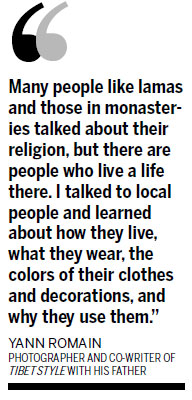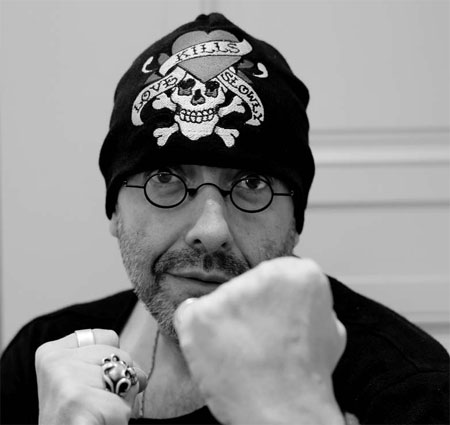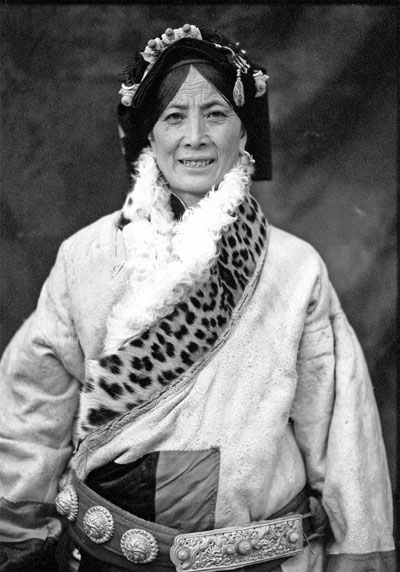A new focal point
Updated: 2012-09-16 08:10
By Yang Yang(China Daily)
|
|||||||
|
Yann Romain is now working on his first film on traditional Chinese theater. Yi Fan / for China Daily |
|
A Tibetan woman he photographed in Sichuan province in 2007. Provided to China Daily |

A top French photographer changes direction in China. Yang Yang finds out where he's heading.
There are at least a couple of things that frustrate Yann Romain about Beijing. One is that it is hard to find a female model "who has not had a face job"; the other is that those who run fashion magazines are often the "young, stuck-up know-it-alls". That is why Romain, 48, a French photographer who has been shooting pictures for fashion magazines in France for 15 years, steers away from the industry in China.
Yet Romain not only lives in Beijing but has made a siheyuan, a courtyard house in the Gulou area, his home for almost a decade.
"When I first came here 13 years ago to spend my holidays, I was amazed by the streets here. It was in November and pretty cold, but people just talked and played in the streets as if they did not feel cold at all. I liked the atmosphere."
He has since spent much of the past 10 years traveling around China, taking photos from the perspectives of fashion and style.
He shot photos for fashion magazines such as Vogue, Madame Figaro, Elle and Glamour, with Madonna, the US pop singer, being his model once.
From 2004 to 2006, he traveled to many ethnic Tibetan areas.
"I went to Lhasa about 20 years ago but was disappointed because it was too commercial for me, so I traveled to Gansu and Qinghai provinces and shot many great pictures," he says.
With Tibetans, Romain focused on their life and style, rather than their religion.
"Many people like lamas and those in monasteries talked about their religion, but there are people who live a life there. I talked to local people and learned about how they live, what they wear, the colors of their clothes and decorations, and why they use them.
"I love colorful things a lot because they make people happy," he says.
In 2006, he co-published a book titled Tibet Style with his father after spending a lot of time with nomads. He tries to reflect in this book the Tibetans' "wealth, pride and honor they have inherited from their ancestors from their finery (that) includes one-armed fur-lined coats, extravagant beaded necklaces, brightly colored fabrics with simple geometric patterns, chased silver jewels studded with semi-precious stones, silk brocade, and scarlet ... robes laden with coral and silver jewelry".
Romain also held photo exhibitions on Tibetan style in Paris.
In 2006, he met a student from the National Academy of Chinese Theater Arts and was introduced to the school to shoot pictures of Peking Opera.
"I'm very interested in the clothes, the practice, the make-up and also how they move on stage," he says.
Romain has experimented with his own styles since 1992 when he found fashion photographs increasingly boring. He asked his father, who specializes in painting with ink and water, to paint on his photos.
Romain used the technique to present his understanding on China's past and present.
He has taken a collection of pictures featuring a young Chinese woman. Onto the photos, he has added many other elements, which are often seen as a postmodern collage of numbers, characters and cuttings from fashion magazines and old pictures.
The focus of the photos is the woman wearing exaggerated hairstyle, make-up, high-heel shoes and fashionable dresses, posing at run-down places where the paint on the walls is peeling off.
"I want to show that young girls in China love spending most money on the latest mobile phones, fashionable clothes and cosmetics," he says. "(But) they have to live in cheap houses."
Some of the photos also portray wistful girls who seem to be longing for love.
Now Romain is ready to direct his first movie, about a traditional local theater in Ninghai county in Zhejiang province. The story is set about 500 years ago. At home in Beijing, Romain has been writing the script intermittently for three months, he says, and it is now almost finished.
"It is a very small budget because it is a new company. The movie is about a big local family that runs a theater business. They have a girl who is very different from other people. She is very adventurous and she falls in love," he says, adding that he wants to show people that China was a very romantic country long ago.
Romain says that when he was young, his mother, a gypsy dancer, often took him to the circus, and he always wanted to blend gypsy culture with traditional Chinese culture. As a result, the theater business in the movie will include animal performances.
"Theater life (in the past) in Asia, like in Europe, was a life of love and passion. I hope my movie can show that kind of feeling," he says. "Some places I have visited in Ninghai still retain that emotion."
Contact the writer at yangyangs@chinadaily.com.cn.
(China Daily 09/16/2012 page5)

